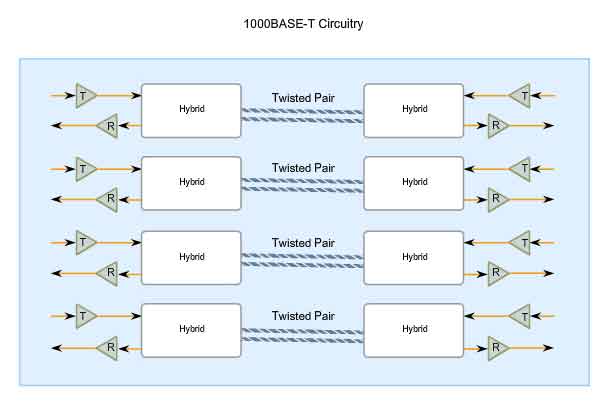1000BASE-T vs 1000BASE-TX
The development of Gigabit Ethernet standards resulted in specifications for UTP copper, single-mode fiber, and multimode fiber. Since Gigabit Ethernet allows transmission speeds of up to 1000Mbps over twisted pair, IEEE 802.3ab defines the 1000BASE-T interface type which uses 4D-PAM5 line encoding to obtain 1 Gbps data throughput. 1000BASE refers to a Gigabit Ethernet connection that uses the unfiltered cable for transmission. “T” means twisted-pair cable (e.g. the common Cat5 in use today).
1000Base-T is a type of gigabit Ethernet networking technology that uses copper cables as a medium. 1000Base-T uses four pairs of Category 5 unshielded twisted pair cables to achieve gigabit data rates. The standard is designated as IEEE 802.3ab and allows 1 Gbps data transfers for distances of up to 330 feet.

1000Base-T came into wide use in 1999, gradually replacing fast Ethernet for wired local networks simply because it was 10 times as fast. Equipment and cables are very similar to previous Ethernet standards and by 2011 were very common and economical. These were the biggest factors that ensured this standard's wide acceptance. 1000Base-T can be used in data centers for fast server switching or in desktop PCs for broadband applications. The biggest advantage of 1000Base-T is that it can use existing copper cabling, negating the need to rewire the system with newer optical fiber cables.
This is a variation of the 1000BASE-T standard. Unlike 1000BASE-T, 1000BASE-TX uses just two of the four pairs in a Cat6 or Cast7 UTP cable. 1000BASE-TX supports full-duplex transmission with a range of up to 100 meters. Because only two of the four pairs are used, Cat6 and Cat7 UTP can support two 1000BASE TX links on the same cable. 1000BASE-TX networks connected with Cat6 UTP cabling are used in Gigabit Ethernet applications that require larger bandwidth than 1000Mbps, such as multimedia content development and streaming, videoconferencing, highly available data centers, and distribution layer cabling. The 1000BASE-TX standard provides a total bandwidth of 2000Mbps using two 1000BASE TX links on the same Cat6 or Cat7 UTP cable.
The main advantage of 1000BASE-T over 1000BASE-TX is obviously the increased bandwidth. Note that although Cat5 UTP supports 1000BASE-T, Cat5e is recommended because the enhanced Cat5e UTP adds specifications for far-end crosstalk.
At present, 1000BASE-T is more commonly used with the lower cost of Cat 5 cabling. However, the design of 1000Base-TX does not require hybrids, nor does it necessitate echo cancellation. Consequently, the design of 1000Base-TX allows for its electronics to be much less expensive than comparable 1000Base-T electronics. So, which is better? It must depend on the plan, budget and application of your project.
As the main fiber optics manufacturer in China, Fiberstore supplies a wide range of 1000BASE-T and 1000BASE-TX optical transceiver modules, including HP J8177C compatible 1000BASE-T SFP transceiver, Juniper EX-SFP-1GE-T compatible 1000BASE-T, Brocade XBR-000190 compatible 1000BASE-TX SFP transceiver, etc. They offer customers high-performance and cost-effective optical fiber products to fulfill their requirements, contributing this way to the customer's success and satisfaction.